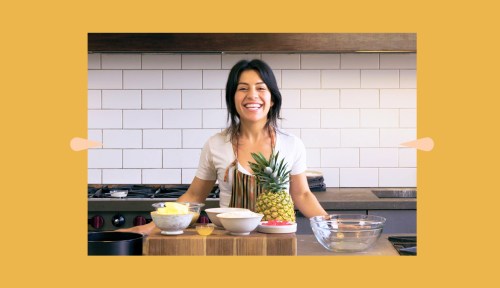Vibrant, decadent, and dripping with sweetness, there’s something irresistible about sinking a fork into a slice of pineapple upside-down cake.
Experts in This Article
Barry’s Bootcamp instructor certified in personal training, HIIT, indoor cycling, and TRX
The tropical fruit on top gives the dessert the illusion that what hides underneath the chunky yellow rounds is just as nutrient-rich. Traditionally, that’s not quite the case. Pineapple upside-down cake is often made with yellow cake mix, butter, and a lot of brown sugar. And not that this divine concoction isn’t delicious, but if you’re looking for a pineapple upside-down cake that’s vegan, gluten-free, and lower in sugar, the latest episode of Alt-Baking Bootcamp has you fully covered.
In the video, baker, personal trainer, and nutrition expert Sashah Handal shows us how to make the vegan pineapple upside-down cake step-by-step with just a few key ingredients. Her goal? To really let those ripe, naturally delectable pineapple rounds shine. Just like an OG pineapple upside-down cake, hers calls for pineapples, cherries, and brown sugar, but she cuts the amount of brown sugar that’s traditionally called for in a few different ways. One is by cooking with coconut oil, which gives natural sweetness and amps up the tropical vibes. “The fat [in the oil] also keeps the pineapple and brown sugar from burning,” Handal says.
Handal also cuts down on the sugar content of the cake by baking it with fresh pineapple instead of canned. It may sound like a no-brainer, but canned pineapple often contains additives and preservatives because it’s drenched in simple syrup. “There isn’t a ton of sugar in the cake itself,” Handal says, adding that the sugar that is used it really just for the caramelized top layer of the cake.
Here’s Handal’s secret to bestowing the dessert with that classic so-spongy texture you expect from a pineapple upside-down cake: she adds pineapple juice and coconut milk to the gluten-free flour. Not only does it add moisture to the blend, but it infuses the batter with fresh tropical flavor that gets folded into every bite (versus just the topping).
Watch the episode above to see her make the cake step-by-step and scroll down for the entire recipe. There’s a reason why this summer dessert is adorned with golden rings on top: it really is a winner.
Vegan pineapple upside-down cake
Ingredients
For the topping:
3 Tbsp coconut oil, melted1 Tbsp brown rice syrup2 Tbsp coconut sugar6-8 pineapple rings, sliced 1/4-inch thickCandied cherries (optional)
For the cake:
1 cup oat flour2/3 cup 1:1 gluten-free all-purpose flour1/4 cup sorghum flour1/2 teaspoon baking powder and baking soda1/4 tsp salt1/2 cup coconut sugar3/4 cup pineapple juice3/4 cup coconut milk (canned)1/4 cup + 2 Tbsp coconut oil (melted)2 Tbsp vanilla1 Tbsp brown rice syrup
1. Preheat the oven to 350°F. Melt three tablespoons of coconut oil and cover the bottom of a springform or cake pan with fat. Sprinkle about two tablespoons of coconut sugar evenly on top of the oil. Place sliced pineapple on top of sugar and oil in a flat, even, but fun layer—get creative here!
2. Add candied cherries in the free spaces between the pineapple pieces.
3. Top pineapple and cherries with a drizzle of brown rice syrup.
4. Combine all dry ingredients in a large mixing bowl and sift to ensure no clumps remain.
5. In a separate bowl, mix all wet ingredients until there is minimal separation of oil.
6. Add wet ingredients to dry ingredients and combine well. The batter should be thick but smooth.
7. Pour batter into pre-prepared cake pan and bake for 15 mins, rotate, then another 15 to 20 minutes. Check for doneness by inserting a fork or cake pick into center; it should come out clean of any uncooked batter.
8. Allow cake to cool for five minutes and then invert onto plate carefully, remember the bottom will now become the top. Eat when cool enough for your mouth to handle. This cake will become even more moist with time, so keep covered in the fridge for up to a week.
Join Well+Good’s Cook With Us Facebook group for more healthy dessert recipes.
Sign Up for Our Daily Newsletter
Get all the latest in wellness, trends, food, fitness, beauty, and more delivered right to your inbox.
Got it, you've been added to our email list.










